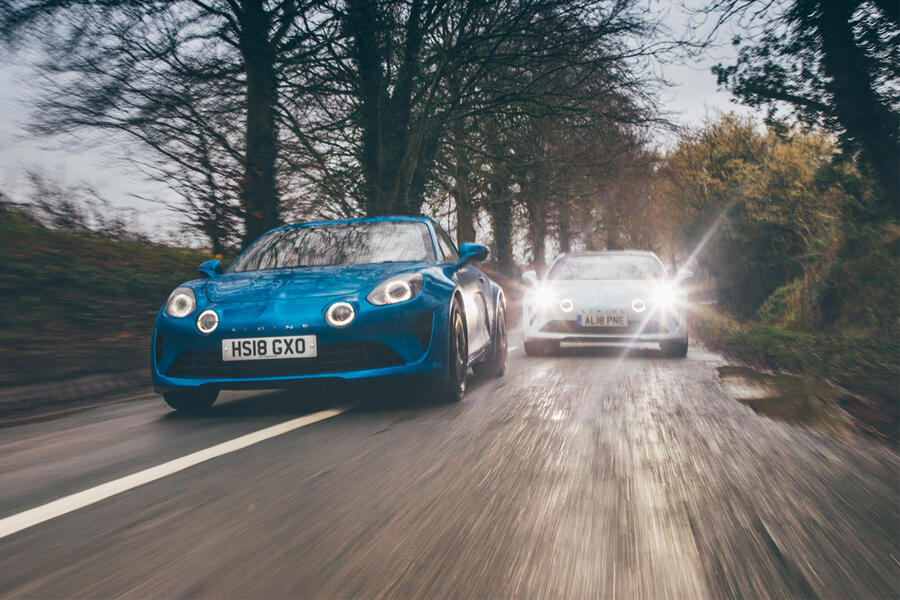Andrew spins a superb yarn but also, I have to say, an unsurprising one. The cars you’ve just read about are mid-engined Porsches. Of course they are going to be fabulous to drive when boiled down to basic dynamics. And yet not everyone has £70,000 to hand, so what exactly is the ‘feelgood factor’ that the 718 Caymans deliver so squarely, and where can you find it further down the food chain?
First, the ‘what’. Feelgood factor can be defined as either the broader automotive experience or something specific within it that makes you smile, outwardly or otherwise. It’s literally that simple. This could be the endearing demeanour of a certain car (Citroën 2CV, Honda E) or it might be sentimental (your parents’ old BMW 323i, now yours), but today we’re focusing on physical sensations and mechanical goings-on.
Of which there are many. Some are easy to comprehend. Light cars with fine throttle response, from the Lotus Elise to the underrated 1.5-litre Mazda 2, offer a powerful sense of connection from the get-go. An excellent driving position is also quickly appreciable, as owners of the Toyota GT86 or Honda Civic Type R will know (and owners of the Honda will know the joy of well-weighted controls, too). I find that progressive and natural-feeling roll rates for the suspension then engender a sense of flow and inspire confidence in the driver, and the effect is even more pronounced when those rates seamlessly match with the steering response. It’s the reason why even a diesel-powered Alfa Romeo Stelvio SUV is sweeter to thread along a B-road than you might imagine. See also the new Ford Focus, which throws real adjustability into the mix even if you go for a basic 1.0-litre Ecoboost with the torsion beam.
So ergonomics, responsiveness and a smooth gait are all key elements. But good balance often underscores feelgood factor whether you’re in an Jaguar F-Type or F150. Despite its uninspiring hybrid motor, the latest Toyota Yaris (yes, really) is very well balanced as well as being pliant. It therefore feels fun and intuitive to sustain momentum by flinging it in to bends. It feels good.

Another obvious win is the oft-invoked ‘fitness for purpose’. Autocar’s Matt Prior will tell you that arguably the sweetest compromise of ride and handling he’s ever experienced is not to be found in a McLaren but in the old Fiesta Zetec S. In chassis terms, Ford’s supermini was almost flawlessly conceived for its role in life and that fact alone made it feel very good to drive.
The engineering behind so many of these factors is complicated and too far beyond my pay grade to even attempt to fully understand or explain here. Steering feel alone is dictated by such elements as the pneumatic trail of the tyres, king-pin inclination, Ackermann geometry, caster angle and scrub radius. But here’s the thing: most of the time, you’ll instinctively know whether it’s been done well, even in humble shopping carts, because of that faint feelgood factor.
Unfortunately, there’s another side to that coin. In the case of steering, even if all those parameters combine to give the desired effect, it’s possible to ruin it all by overassisting the rack, gearing it too slowly or too fast (or too inconsistently), or simply by fitting a steering wheel rim that’s excessively thick.
The same thinking applies elsewhere, and for every kind of car. Expensive suspension systems calibrated to wafting perfection can be undermined by poor seats or poor visibility. Spirited engines can be lumbered with lumpy gearboxes, or lazy fly-by-wire throttle control. It means that, ultimately, it’s very easily possible for one feelgood element of the driving experience to be drowned out by poorer attributes. Net result? Feel-not-so-good. The Volkswagen Up GTI gets so much right but the strict ESP really does quell the fun. Meanwhile, the Cayman gets almost everything right, so its net feelgood factor swells to something beyond the sum of its parts.

Now, the ‘where’. Feelgood factor is clearly not the exclusive preserve of very expensive machines, so where does it really all come together for sensible money? Being small, light, responsive, playful and generally very true to the strengths of their respective layouts, the Mazda MX-5 and Ford Fiesta are predictably rich in feelgood factor. And Mazda’s form extends throughout its range. The 2 in range-topping form is especially good, being agile, linear in its controls and, in the words of road test editor Matt Saunders, “no slave to the grip level”. We’d also put the basic Mini Cooper, on the smallest wheel option possible, without run-flat tyres and with the standard suspension, in the clique of feelgood superminis. Of the larger hatchbacks, frankly the only standout in the class is the Focus, although the refinement and cabin quality of bygone Audi A3s really did give you a feelgood lift.
Spend more money and the basic BMW 320d is quietly rewarding in a classic rear-driven way and brilliantly keen to change direction. Equally, the Alfa Romeo Giulia is softer on the move but perhaps even richer in its sense of pushing – rather than pulling – itself down the road. Both cars are stellar even at a canter, without much to undermine the experience. And yet the opulence of a Mercedes-Benz E-Class riding on air springs and sensibly sized wheels is every bit as satisfying, just differently so.
Spend more still and you’re into the realm of arguably the greatest feelgood car of this era: Alpine’s Alpine A110. The French car’s steering could be sweeter and it should have a manual gearbox, but the low mass, accessible torque and conservative spring rates combine to deliver an intravenous shot of feelgood factor. Driven at pace, it’s an obedient and joyful extension of your body, simple as. I’d also add the four-cylinder Jaguar F-Type to this list, on the strength of its chassis dynamics and old-school GT vibe.

But again, the magical thing about feelgood factor is that it can crop up anywhere, and so it also flows forth richly, albeit for largely different reasons, from the Alpine’s distant and less exalted corporate cousin. I’m talking about the £11,000 Dacia Duster, which is a joy. Feelgood factor: it doesn’t care much for high prices, fat tyres or colossal power.
READ MORE
McLaren 720S vs Mazda MX-5: Which is the most fun?
No bum steer: The importance of steering feel
Britain's Best Driver's Car: Our favourites of the last three decades



















Join the debate
Add your comment
Feel good factor, my little
Damned by faint praise?
"The refinement and cabin quality of bygone A3s really did give you a feelgood lift."
Zeddy wrote:
I get the impression from recent Autocar articles that certainly cabin quality on the latest A3 (and some VWs) is suffering from a bit of cost-cutting. No doubt to offset all the expense of group investment in EVs.
streaky wrote:
And to fund the extensive fines they are having to pay around the world